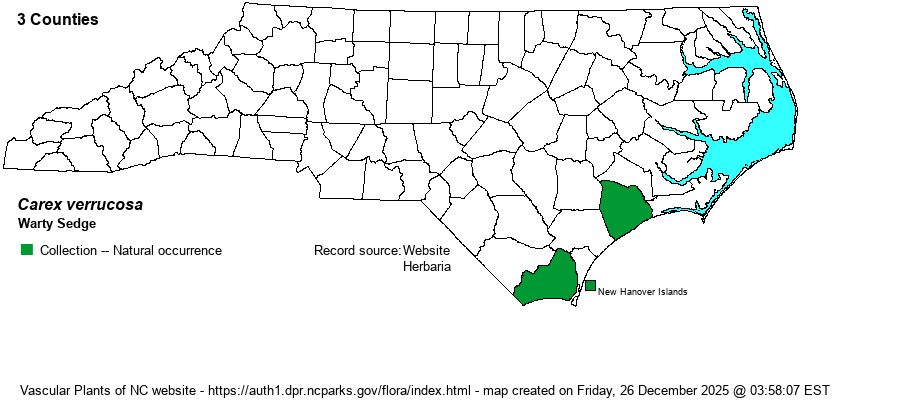| Author | Muhlenberg | |
| Distribution | Carex verrucosa blooms in late spring, and fruits mature in June - early July. By contrast, C. glaucescens and C. joorii bloom in July-August and fruit later, but nonetheless have been misidentified as C. verrucosa. At this point in time, sight records cannot be accepted. One website editor (Sorrie) believes that the species has been greatly over-reported, such as in the NCNHP database, which lists records for 11 counties (many from Carolina Vegetation Survey plots), including a few in the Sandhills region where Sorrie has never seen C. verrucosa. The map is probably conservative, but caution on identification of records is warranted. The range in the state is essentially limited to the southeastern coastal counties, until proven otherwise.
Southeastern NC south to southern FL and west to eastern TX. | |
| Abundance | Apparently rare, but exact abundance level is clouded by probable misidentifications. This is a Significantly Rare species. | |
| Habitat | Restricted to Carolina bays with cypress, and natural bay-like depressions. |
| Phenology | Flowering May-June and fruiting June-July. See Distribution for additional comments. | |
| Identification | Mature female spikes of C. verrucosa remain erect or ascending, whereas they arch or droop when mature in C. glaucescens and many C. joorii. C. joorii also differs by the acute apex to female scales (vs. truncate or retuse). See also the information on timing of flowering/fruiting of C. verrucosa vs. the other two. | |
| Taxonomic Comments | None, though see the specimen confusion mentioned above.
The genus Carex is the largest in North America, and among the largest in the world. In temperate and boreal regions, Carex is often the dominant or co-dominant ground layer in many habitats. Seeds (achenes) are valuable food for birds and small mammals, while foliage is used by birds and mammals to make nests and as food by mammals. Species of Carex often look vastly different from one another -- spikes erect vs. drooping, tiny inflorescence vs. whopping, culms leafy vs. naked, perigynia beaked vs. beakless, stems densely bunched vs. single, etc. The genus has been divided into many sections (or groups), based on shared characters; some taxonomists have suggested that these be different genera, but that proves unworkable (so far). All Carex share the feature of a perigynium (an outer covering) which completely surrounds the achene (seed). This covering may fit tightly or loosely (like a small bladder), depending on which group or species. Details of perigynia shape, ornamentation, presence and size of beak, number of striations (or veins) are all important ID features. In recent years Rob Naczi and colleagues have stressed the importance of arrangement of perigynia -- whether spiral (3+ ranks) or distichous (2-ranked) -- and have named a number of new species as well as split off some older synonyms. Therefore, RAB's (1968) key, excellent for its time, can only be used in a general way today. Members of some sections of Carex are difficult to key out (notably Ovales, Laxiflorae, Griseae); this is in part due to variation among individuals of a species, or failings of the key. FNA has drawings of most species and some species may be found in two or more places within a key, to acount for variability. New species to NC, and new to science(!), continue to be found in NC. | |
| Other Common Name(s) | None | |
| State Rank | S2 | |
| Global Rank | G4 | |
| State Status | SR-P | |
| US Status | | |
| USACE-agcp | OBL link |
| USACE-emp | OBL link |

